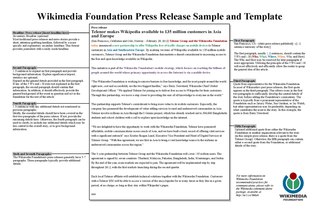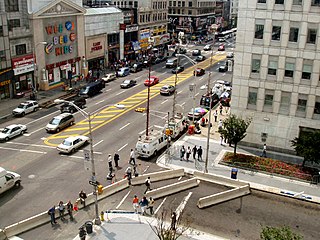In English writing, quotation marks or inverted commas, also known informally as quotes, talking marks, speech marks, quote marks, quotemarks or speechmarks, are punctuation marks placed on either side of a word or phrase in order to identify it as a quotation, direct speech or a literal title or name. Quotation marks may be used to indicate that the meaning of the word or phrase they surround should be taken to be different from that typically associated with it, and are often used in this way to express irony. They are also sometimes used to emphasise a word or phrase, although this is usually considered incorrect.
A paragraph is a self-contained unit of discourse in writing dealing with a particular point or idea. Though not required by the orthographic conventions of any language with a writing system, paragraphs are a conventional means of organizing extended segments of prose.

The inverted pyramid is a metaphor used by journalists and other writers to illustrate how information should be prioritised and structured in prose. It is a common method for writing news stories and has wide adaptability to other kinds of texts, such as blogs, editorial columns and marketing factsheets. It is a way to communicate the basics about a topic in the initial sentences. The inverted pyramid is taught to mass communication and journalism students, and is systematically used in English-language media.

A press release is an official statement delivered to members of the news media for the purpose of providing information, creating an official statement, or making an announcement directed for public release. Press releases are also considered a primary source, meaning they are original informants for information. A press release is traditionally composed of nine structural elements, including a headline, dateline, introduction, body, and other components. Press releases are typically delivered to news media electronically, ready to use, and often subject to "do not use before" time, known as a news embargo.

The news media or news industry are forms of mass media that focus on delivering news to the general public. These include news agencies, newspapers, news magazines, news channels etc.

In journalism and mass media, sensationalism is a type of editorial tactic. Events and topics in news stories are selected and worded to excite the greatest number of readers and viewers. This style of news reporting encourages biased or emotionally loaded impressions of events rather than neutrality, and may cause a manipulation to the truth of a story. Sensationalism may rely on reports about generally insignificant matters and portray them as a major influence on society, or biased presentations of newsworthy topics, in a trivial, or tabloid manner, contrary to general assumptions of professional journalistic standards.
The headline is the text indicating the content or nature of the article below it, typically by providing a form of brief summary of its contents.
Journalese is the artificial or hyperbolic, and sometimes over-abbreviated, language regarded as characteristic of the news style used in popular media. Joe Grimm, formerly of the Detroit Free Press, likened journalese to a "stage voice": "We write journalese out of habit, sometimes from misguided training, and to sound urgent, authoritative and, well, journalistic. But it doesn't do any of that."
Open-source journalism, a close cousin to citizen journalism or participatory journalism, is a term coined in the title of a 1999 article by Andrew Leonard of Salon.com. Although the term was not actually used in the body text of Leonard's article, the headline encapsulated a collaboration between users of the internet technology blog Slashdot and a writer for Jane's Intelligence Review. The writer, Johan J. Ingles-le Nobel, had solicited feedback on a story about cyberterrorism from Slashdot readers, and then re-wrote his story based on that feedback and compensated the Slashdot writers whose information and words he used.

The Five W's and H is a checklist used in journalism to ensure that the first paragraph contains all the essential points of a story. As far back as 1913, reporters were taught that the lead should answer these questions:
Narrative Journalism, also referred to as literary journalism, is defined as creative nonfiction that contains accurate, well-researched information. It is related to immersion journalism, where a writer follows a subject or theme for a long period of time and details an individual's experiences from a deeply personal perspective.
In article structure for journalism, the nut graph or nut graf is a paragraph that explains the context of the story "in a nutshell". The term can be spelled many different ways.

A feature story is a piece of non-fiction writing about news covering a single topic in detail. A feature story is a type of soft news, news primarily focused on entertainment rather than a higher level of professionalism. The main subtypes are the news feature and the human-interest story.
A lead paragraph is the opening paragraph of an article, book chapter, or other written work that summarizes its main ideas. Styles vary widely among the different types and genres of publications, from journalistic news-style leads to a more encyclopaedic variety.
The term "journalism genres" refers to various journalism styles, fields or separate genres, in writing accounts of events.
Betteridge's law of headlines is an adage that states: "Any headline that ends in a question mark can be answered by the word no." It is named after Ian Betteridge, a British technology journalist who wrote about it in 2009, although the principle is much older. It is based on the assumption that if the publishers were confident that the answer was yes, they would have presented it as an assertion; by presenting it as a question, they are not accountable for whether it is correct or not. The adage does not apply to questions that are more open-ended than strict yes–no questions.
The Maestro concept is a time-management technique used in journalism in order to assist the newsroom to work in a project-based, teamwork-intensive manner by "thinking like a reader".
The following outline is provided as an overview of and topical guide to journalism:
Article structures in journalism encompass various formats to present information in news stories and feature articles. These structures reflect not only a writer's deliberate choice but also a response to editorial guidelines or the inherent demands of the story itself. While some writers may not consciously adhere to these structures, they often find them retrospectively aligned with their writing process. Conversely, others might consciously adopt a style as their story develops or adhere to predefined structures based on publisher guidelines.
This glossary of journalism is a list of definitions of terms and concepts used in journalism, its sub-disciplines, and related fields, including news reporting, publishing, broadcast journalism, and various types of journalistic media.







